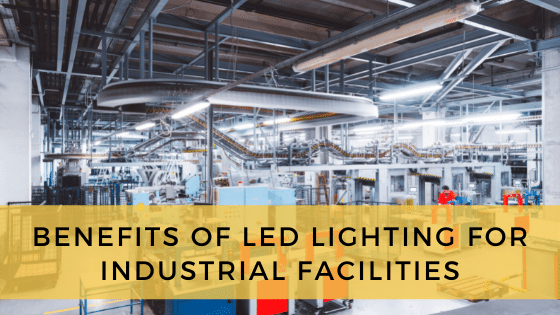
Benefits of LED lighting for industrial facilities is something that is often overlooked when in reality they have the potential to make work more productive and efficient. The lack of appropriate lighting could lead to quality control and safety issues for both workers and consumers, a situation that could be avoided with better lighting.
If you are the owner of an industrial facility and are finding yourself or your employees noticing inefficient lighting or the constant stoppage of work to replace light bulbs take a few minutes to learn about LED lighting and the benefits it can provide for your facility.
Drawbacks of an Industrial Facility Without LED Lighting
Lighting paves the way for the majority of things we do on a daily basis. It’s readily available and easy to take for granted without even realizing it. For industrial facilities proper high bay lighting is a necessity, but the question then becomes are you making your lighting really work for you? Is it helping your business to thrive?
Subpar lighting can lead to serious and potentially dangerous problems including but not limited to:
- Safety hazards
- On the job injuries
- Improper product assembly
- Compromised product lines
- Repeated failure of quality inspections
Not only could these situations put workers’ safety at risk, but it might also have the power to negatively impact a company’s bottom line. In short, subpar lighting is not an option for industrial facilities which is why many are turning to LED lighting in record numbers.
LED Lighting
Lighting is a key component of the workplace. Subpar lighting can make most kinds of tasks nearly impossible to do. What many companies do not realize is that the type of lighting they use can impact their bottom line, for better or worse.
Historically, lighting has been comprised of options such as high-pressure sodium, florescent, or metal halide lighting. While these may have been ahead of their time years ago, the mass use of LED or light emitting diode lighting is quickly making these options more obsolete. For example, many LED bulbs have the capacity to produce light up to ninety percent more effectively than most incandescent bulbs.
LED bulbs also tend to last much longer than their older counterparts. The longer lifespan of a bulb can equal less time replacing bulbs which means less lost time in a facility that would have normally had to shut down to replace these bulbs. As an added perk, LED lights seldom go out unexpectedly with a bright flash. They are instead designed to slowly dim over time, allowing companies a longer window to replace a bulb when needed.
Benefits of LED Lighting for Industrial Facilities
LED lighting is earning its place in businesses, warehouses, and industrial facilities across the nation as companies seek to improve their lighting efficiency. While it is worth noting that a company may have to pay upfront costs to have lights retrofitted for LED capabilities, this option yields savings on energy bills that will eventually pay for the installation.
When considering the advantages of using LED lighting, it can make any other type of lighting seem like an inefficient use of resources. Some of the key benefits of LED lighting for industrial facilities include:
- Encouraging alertness – Workers may become prone to be less focused during a mid-afternoon post lunch slump or in the early morning for those that work night shifts. A significant but often unmentioned benefit of LED lighting is that its direction and brightness can assist in keeping some workers more alert.
- Creating a higher level of safety – In addition to the brighter, directional power of LED lighting, there is the added benefit of offering facility workers a higher level of safety that can come with improved indoor visibility. Using LED lighting in this setting may help prevent accidents caused by poor visibility such as injuries, collisions, or misuse of special equipment.
- Improving quality control – LED lighting has the capacity to be directed to specific areas rather than uniformly blanketing larger areas. This allows the light to be directed to areas with the greatest need for focused light, such as quality check of production.
- Less switching out of light bulbs – Once the initial retrofit is performed to allow for LED lighting, these lights tend to last for longer periods of time than some less modern options. This saves companies from having to replace light bulbs as frequently which is instrumental in keeping facility production running smoothly and avoiding shutdowns for bulb replacements.
- Saving on energy bills – Since LED lights tend to last longer than their more traditional counterparts, when used in a high bay lighting setting it could reduce the amount of energy used by as much as sixty percent. This type of savings can have a welcome domino effect when used on multiple fixtures and may allow a facility to put energy bill savings toward other areas of need.
It can be easy to look at the above and think this would be helpful but not doable in terms of time or money. It may be helpful to stop and translate some of these bullet points into actual dollar amounts. For example, how much money would the company stand to save in one year if the energy bill is cut by sixty percent? How could those same savings add up over two years? The answer may have you realizing that the time and money you spend up front on this type of upgrade can more than pay for itself over time with energy savings.
The benefits of LED lighting for industrial facilities are too abundant to ignore for the company owner that seeks high levels of efficiency and productivity. Reach out to a reputable lighting provider today to learn what switching to LED lighting could mean for your facility.






